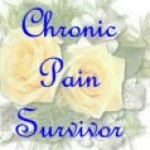Home Page › Forums › General Discussions on Pain › Non-medication Interventions for Breakthrough Pain
- This topic has 8 replies, 6 voices, and was last updated 8 years, 6 months ago by
 Janice-R.
Janice-R.
-
AuthorPosts
-
-
April 25, 2013 at 10:10 am #4433
 Janice-RParticipant
Janice-RParticipantIf you are anticipating or have breakthrough pain what are your non-medicine things you do to prevent needing to take medication. The thing that is most effective for me is sitting in a dim or dark room and watching some favorite TV (I am a Sci Fi buff). It doesn’t always work but more often than not especially if I catch it in time. Sometimes it is as simple as having something to eat if I am hungry (which I can never quite figure out as it is my head that hurts). Meditative breathing can also be helpful sometimes. What works for you?
-
April 26, 2013 at 12:14 pm #4441
 Noki4Participant
Noki4ParticipantFor me it is finding something to distract me from the pain. I use Facebook, volunteer work and some crafts to keep my mind distracted.
-
September 12, 2013 at 10:27 pm #4705
jlclarke3
MemberI have taken a few courses through a “tele-health” program they offer in Ontario Canada. This is where a Dr. Jackie Gardner-Nix (spelling?) is at her hospital in Toronto with a group of people and then there are satellite groups all across the province at the same time. She gives us tools to deal with our chronic pain. One tool that is often used is meditation. Some of her meditations have really helped me when I get to that dark place where you eat, sleep, breath pain and you don’t feel you can get out of it. You may want to look her up. She has made some cd’s with different meditations on them….
I too find solace in doing some crafts to get my mind off the pain. I will work on a project and leave it set up at my desk and will go back and forth with breaks in between. (this also helps with staying away from the munchies when you are just sitting and watching tv).
Hope this helps -
January 11, 2015 at 3:03 am #5525
 qualiaParticipant
qualiaParticipantChronic Pain is the only malady where patients are encouraged NOT to take their meds, regardless of the dangerous consequences during breakthrough like change in pain for the worse. seizure, stroke, heart attack etc. The last time I hit a 10 (and by every definition out there I hit a medical 10) I made my right trigeminal nerve worse and now I have chronic tearing in my right eye and it has been tearing and puffy for months and it is horrible. And I was IN HOSPITAL BEGGING for medicine when this happened, but they refused to give me anything besides things I can’t take, so when I said no to the topomax and lyrica they said I was “refusing treatment” and “non compliant”, which I wasn’t, I was trying to avoid paradoxiacal reaction and horrible side effects. It’s like there is a fatwa on properly treating breakthrough pain these days, it’s torture, unethical and nonsense.
-
January 23, 2015 at 10:44 am #5541
 Noki4Participant
Noki4ParticipantIt is sad but you are right Qualia. We are encouraged not to use pain medications. I just keep thinking with all the break-throughs in technology and such. Why is it so hard for researchers and healthcare providers to understand chronic pain?
-
February 4, 2015 at 12:00 pm #5551
 Micke Brown, BSN, RNParticipant
Micke Brown, BSN, RNParticipantI recently found myself nursing (pun intended) back pain that caused heel pain when standing & walking (most likely a back strain involving L5-S1 and or my SI joint). I am a big fan of thermal techniques, so I started with wearing a Tiger Balm patch during the day and switching to my heating pad at night. NSAID’s helped a tad plus stretching more, elevating my desk chair to improve my posture and wearing supportive shoes during the day. Some days were better than others, but I did not feel I was mending as expected. I had to modify my walk schedule which makes my dogs most unhappy. It dawned on me after speaking with a friend, that I might switch to ice therapy………duh, knock on wood—after a few days, I am feeling better. I guess I had more swelling than anticipated. Fingers Crossed, okay?
-
September 21, 2015 at 7:27 pm #14947
 LizzbenParticipant
LizzbenParticipantMy pain is a little..odd I guess and so the only way I can relieve pain is to curl up into the fetal position. Since I tend to have very sharp pains that incapacitate me, I make sure that I always have a designated location where I can lay/sit comfortably at work/home/etc. I’ve also added in deep breathing along with tapping my fingers to help distract myself from the pain. I’ve given my chronic pain a name (Carl) and whenever I’m having a bad pain day I can just tell people that Carl is upset and it becomes understood with the people around me. Other things I use are calming music without words to help ease myself so I don’t tense up my muscles. If I’m able to, I might try to play a game or talk or something, but typically I end up lying on the floor in the fetal position and I focus on important things there whether it’s reading or talking with friends. At least for me, it’s very important to not let my chronic pain control my actions too much. I don’t always get to do things the way normal people do, but I’ve adapted my strategies with life so that I can still accomplish all of my goals.
-
October 7, 2015 at 7:04 pm #16825
 Noki4Participant
Noki4ParticipantI love how you said that it is important to not let the pain control your actions too much. That is wonderful!
We must never let the pain control us or own us. I talk out loud to my pain and I tell my pain to back off and that it will not cause me to stop living my life.
Moving forward always — take care
Noki4
-
October 16, 2015 at 10:28 am #17871
 Janice-RParticipant
Janice-RParticipantIt is important not to let your pain own you or define you but it is equally important to understand limits and not put yourself in a position to aggravate your pain. I would love to be the “fun” grandma (the one who takes them to the Wild life center or to Boston, or even apple picking) but I just can’t. I am the Grandma who is the good cook and also teaches them to love reading; just different.
When I posted this question I did so with the intent of seeing what manner of non-pharmacological interventions people were employing. This interventions should be part of one’s pain plan and rarely, if ever its sole component.
The two issues concerning non-pharma interventions which are greatly troubling are 1) there are hundreds of pain syndromes under the umbrella of pain and not all interventions are appropriate for all pain (exercise increases my pain quite a bit) and not all interventions work for everyone (tried acupuncture-my pain actually got worse). 20 Financial issues are a huge one for many non-pharma interventions; either no insurance, or insurance will not pay at all or pay an insufficient amount. Massage really helps keep the amount of opioids I need down and about the largest gap is two weeks (please note this in addition to meditation, guided imagery, and warmth to the base of my skull These plus two non-opioid pain medications keep my opioid use low-a goal for any medication. My insurance does not pay for any non-pharma interventions and we have gotten into a very tight financial situation so I have had to change from every 4 weeks instead of every other week. This plus the added stress of the financial situation has increased my need for breakthrough medication). MaineCare (our Medicaid) doesn’t allow opioids unless you have “failed their non-pharma interventions and non-opioid medications (and then a board decides. Their choice of non-pharma is PT, osteopathic manipulation, and Cognitive therapy (only research done was on patients using opioids). Now not only do these interventions not work for everyone, the first two are limited to 6 visits a year. There is no provision for transportation either. To see the importance placed on non-pharma interventions by new guidelines is ignorant.
Please sill love to hear what you are using. The warmth at the base of the skull I came across accidently. Unfortunately it only helps while it is being applied but it can avert taking medication for break through. My daughter has found it helpful for headaches as well.
-
-
AuthorPosts
- You must be logged in to reply to this topic.
